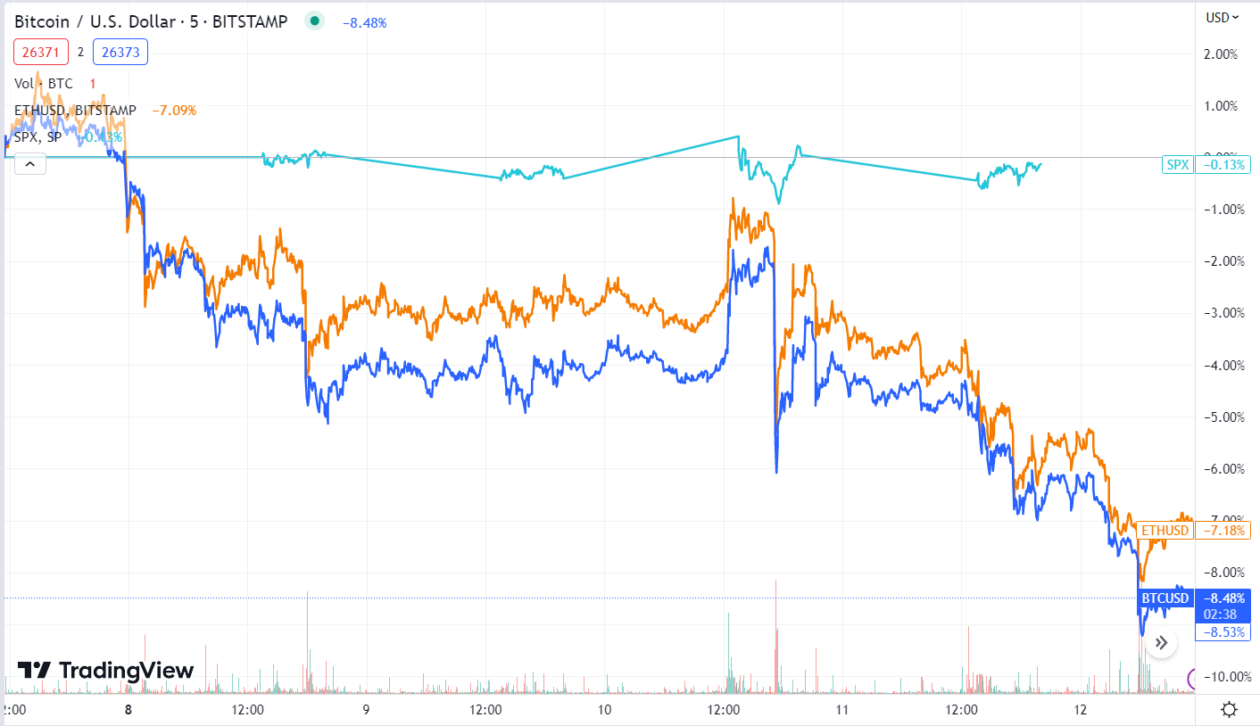Bitcoin fell 9.42% from May 5 to May 12 to trade at US$26,365 as of 7:30 p.m. on Friday in Hong Kong. The world’s largest cryptocurrency by market capitalization has been trading under US$30,000 since April 19. Ether fell 7.3% over the week to US$1,765, losing the key US$1,800 support level.

The U.S. Consumer Price Index (CPI) released this week showed slower headline inflation in April, boosting hopes for the Federal Reserve to pause rate hikes next month. U.S. annual inflation slowed to 4.9% last month, from 5% in March, but gained 0.4% on the month.
Bitcoin briefly topped US$28,300 following the release of U.S. inflation data, but has since been trading lower.
“Bitcoin dropped to US$26,900 after rejecting from the ~US$28,200 area. The reaction from the ~US$26,900 area was quite strong,” tweeted pseudonymous crypto analyst Rekt Capital. “The US$28,200 resistance is the resistance to beat if the price is to enjoy bullish momentum,” he added.
The global crypto market capitalization stood at US$1.1 trillion on Friday at 07:30 p.m. in Hong Kong, down 8.33% from US$1.2 trillion a week ago, according to CoinMarketCap data. Bitcoin’s US$510 billion market cap accounted for 46.3% of the market, while Ether’s US$214 billion accounted for 19.4%.
Bitcoin stuck in traffic
In another milestone for the world’s first blockchain, the number of non-zero balance Bitcoin addresses reached an all-time high of 46.6 million on Thursday, boosted by the surging interest in Ordinals, a protocol that allows data to be inscribed in the smallest monetary unit of Bitcoin, according to on-chain data analytics firm Glassnode.
As a result, Bitcoin congestion issues worsened. The network faced a growing backlog of transactions exacerbated by the network surpassing 5 million Ordinals inscriptions, fueled by the arrival of memecoins in the form of BRC-20 tokens, a fungible token standard built on Ordinals protocol. BRC-20 tokens surpassed US$1 billion in market capitalization on Tuesday.
Adding to the negative market sentiment, Binance temporarily halted Bitcoin withdrawals twice in 12 hours on Monday, due to a “large volume of pending transactions.” The world’s largest crypto exchange resumed Bitcoin withdrawals on the same day, while Bitcoin fell as low as US$27,419 on Monday.
“[The correction] was highly due to that since Binance witnessed historically-high BTC outflows,” said Leena ElDeeb, a research associate at 21.co, the parent company of 21Shares, an issuer of crypto exchange-traded products.
Bitcoin supply on exchanges fell to a five-year low of 5.84% on Tuesday, according to crypto analytics firm Santiment, indicating that long-term holders are increasingly opting for self-custody solutions.
“The downtrend was also influenced by misinformation on Twitter, calling the congestion a denial of service attack when, in fact, it was increased demand that led to that congestion and skyrocketing transactions only meant that people were willing to pay more money for faster settlements,” ElDeeb added.
Nilesh Verma, crypto market analyst and founder of Crypto Granth consultancy in India, pointed to a separate thread of inaccurate information dissemination surrounding the U.S. government and its Bitcoin holdings as a significant factor in the declining value of Bitcoin this week.
Misinformation emerged on Wednesday, stating that the U.S. government started selling its Bitcoin holdings. According to a March 31 court filing, the U.S. government seized 51,351.89 Bitcoin (worth US$1.4 billion) from Ross Ulbricht, the creator of the darknet marketplace Silk Road. The government sold 9,861 Bitcoin (US$279 million) on March 14 and is planning to sell the remaining 41,490 Bitcoin (US$1.1 billion) in four batches this year.
“Someone shared fake news that the U.S. government will sell Bitcoin by showing the wrong labeling on the Arkham Platform… same we saw on April 27, when Bitcoin dropped from US$29,000 to US$27,000 on a glitch in the Arkhram platform,” Verma said.
Market analysis
Crypto Granth’s Verma said that Bitcoin has strong support around US$26,111. “Bitcoin has to hold this support for continued bullish momentum. As of now, we can see a retest of this area. We believe that we will see strong buying near US$25,000-26,000. Weekly closing below US$26,000 will make Bitcoin bearish,” wrote Verma.
But Dr. Jeff Ross, founder and chief executive officer of investment firm Vailshire Capital Management, said Bitcoin needs to dip lower before starting a new rally.
“Short-term momentum indicators need one more flush lower, ideally to US$24,000, to complete the healthy reset and begin the next leg higher, starting in mid-to-late May,” wrote Ross on his verified Twitter account.
Biggest gainers:
Kava, the governance token of a layer-1 blockchain of the same name, was this week’s biggest gainer among the top 100 coins by market capitalization listed on CoinMarketCap. Kava rose 17% to US$0.9204, after the protocol announced that its mainnet launch is one week away.
Bitcoin SV (BSV) – a fork of Bitcoin Cash focused on scalability – was this week’s second biggest gainer, rising 8.47% to US$35.88. The token saw a surge of interest after congestion on the Bitcoin network caused transaction fees to rise .
See related article: Central Banks’ actions move Crypto; Standard Chartered eyes $100K Bitcoin
Next week: All eyes on the U.S. debt ceiling
Negotiations over raising the U.S. debt ceiling of US$31.4 trillion to keep the government solvent continued on Wednesday, with congressional Republicans demanding more budget cuts. President Biden’s meeting with top Congress leaders planned for Friday was postponed to next week, three sources familiar with the matter told NBC News.
Investors are also anticipating Europe’s Harmonised Indices of Consumer Prices report, scheduled for next Wednesday. Euro area annual inflation for April is expected to come in at 7% for April, up from 6.9% in March, according to flash estimates from Eurostat, the European Union’s statistical office.
In the crypto space, liquid Ether staking protocol Lido Finance is preparing for its V2 upgrade, enabling Ether and staked Ether (stETH) withdrawals directly on the protocol. The Lido DAO is set to vote for the V2 upgrade starting today, from 10 p.m. Hong Kong time. With the community’s approval, the upgrade is expected to go live next Monday.
Web 3.0 gaming protocol Gala Games is also preparing for a contract upgrade on Monday. The protocol will issue its new Gala V2 token in a 1:1 ratio for all Gala token holders, while support and utility for the initial token will cease simultaneously. While most major exchanges signaled their support for the new token, Coinbase stated that it will not be supporting Gala V2.
See related article: Crypto and NFT Market Update – May 11th






